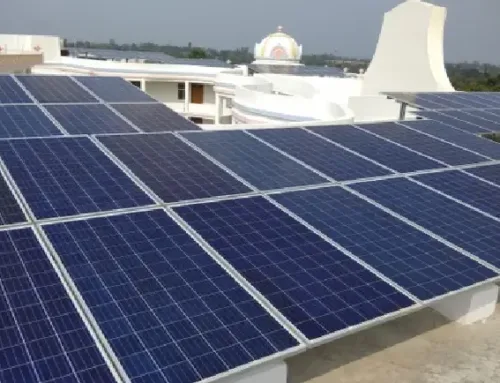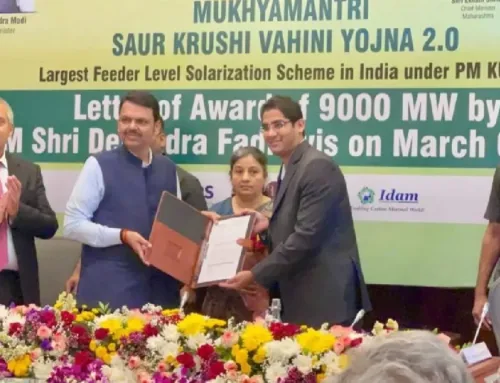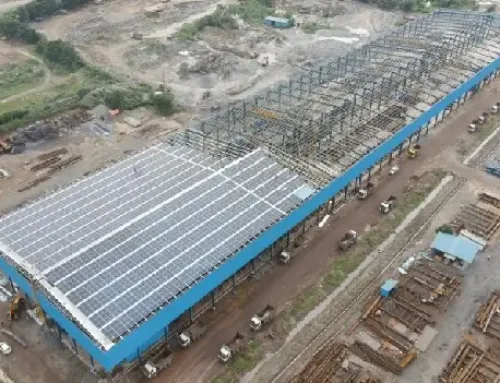
Does it matter what type of solar panel I buy?
Yes, it does!
Contrary to popular belief, not all solar panels are the same. In India, you can find four different types of modules that differ not only in their production and appearance but also in their cost and efficiency.
A little knowledge about how panels work and what makes them different will undoubtedly make your buying process much easier.
Four Types of Solar Panels
1. Monocrystalline Modules

Solar cells are manufactured using a semiconductor material called silicon. This element is not only more efficient in converting light into electricity but also abundantly available on our planet.
In both monocrystalline and polycrystalline modules, silicon wafers are assembled into rows and columns and shaped into a rectangle. This rectangle gets covered with a glass sheet.
However, in monocrystalline panels, solar cells are made using a single silicon crystal. This pure crystal is called a monocrystalline ingot. The production of these crystals is complex and generates a lot of silicon waste, which raises the cost of solar modules.
Here are some features of mono panels:
- Due to the additional cost of creating pure silicon crystals, mono panels are the more expensive than other panels.
- The efficiency of these panels is much higher than other types. With the advancement in technology, the efficiency of mono panels can now reach over 20%
- Monocrystalline panels are mostly available in higher power wattages with power output up to 600 Wp. This leads to a higher generation.
- The cells in these panels have a black tint.
Monocrystalline panels are also available in half-cut cell technology. In this type, the square-shaped solar cells are cut in half, which leads to double the number of cells in a single module. The cells in the top portion are part of one series, while those at the bottom are part of another.
As a result, if the top portion gets shaded, the bottom continues to generate energy. Half-cut cell panels generate more power than their counterparts.
2. Polycrystalline Modules

The solar cells in polycrystalline modules are manufactured using fragments of silicon crystals. This is why poly modules are also called multi-crystalline modules.
The silicon waste left behind during the process of creating pure silicon crystals is melted together into a mold. The mold is then sliced into wafers to create solar cells.
Features:
- Since the manufacturing process is much simpler, the cost of poly modules is cheaper than that of mono panels.
- These modules have an efficiency between 15-17%, which is lower than other types of panels.
- Poly panels usually come in lower wattages and thus have a lower power output.
- Poly panels have a bluer tint.
3. Thin Film Modules

The thin film module is lighter weight and slimmer than the mono and poly modules. Unlike the other two, thin film panels do not rely on silicon.
Most thin film solar panels are made using these 3 specific photovoltaic substances: cadmium telluride (CdTe), amorphous silicon (a-Si), and copper indium gallium selenide (CIGS). To produce the panels, manufacturers place the material between two transparent conductive layers of glass or plastic.
Features:
- Due to their thin size and higher manoeuvrability, these panels are easy to install.
- The panels are cheaper than other types as they are easier to manufacture
- These panels have the lowest efficiencies and power output levels among all the other types of solar panels.
- As the panels have a small shelf life, they are not suitable for residential and commercial purposes and are mostly employed for utility-scale projects.
- Panels can have blue or black tint, based on the material used in manufacturing
4. MONO PERC Modules

Mono PERC (Passivated Emitter and Rear Cell) is a relatively newer technology and an upgraded version of the Monocrystalline modules.
Conventional modules do not absorb all the sunlight it receives. Most of it passes through the frame. To counter this problem, manufacturers added a layer on the back of the solar cells in the Mono PERC modules.
Features:
- Mono PERC modules absorb the light that is reflected by the ground.
- The panel’s efficiency and power output are higher than any commercially available module in the market.
- The cost of these panels is also higher than other types of panels in the market.
| Properties | Monocrystalline | Polycrystalline | Mono PERC | Thin Film |
|---|---|---|---|---|
| Appearance | Black hue | Blue Hue | Black Hue | Can be blue or black |
| Efficiency | High | Medium | High | Low |
| Cost | High | Low/Medium | Highest | Low |
| Power Output | High | Medium | Very High | Low |
About Ornate Solar
Ornate Solar is the one of the leading distributors of solar panels, inverters and solar accessories in India. If you are exploring solar panels you can connect with Ornate Solar to get the best prices on Canadian Solar panels (Mono PERC, Mono & Poly) and RenewSys solar panels (Mono PERC & Poly).
For more information please give us a call at 011 4353 6666.















Leave A Comment